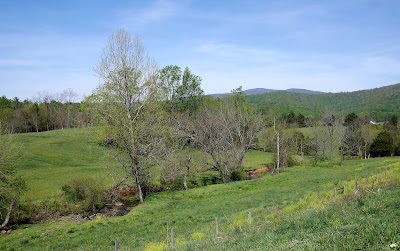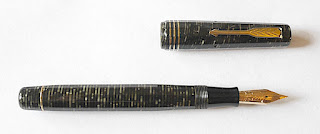Having spent a wonderful weekend celebrating Passover with
family in Virginia’s Shenandoah Valley, Monday saw us heading eastward through
Virginia, destination Virginia Beach, our launch point as we head across North
Carolina to Myrtle Beach. We bought lunch and drinks for tomorrow at the local
Harris Teeter. We also gassed up and will buy only enough gasoline to get us out of NC.
On the advice of my cousin Ron, we took backroads through
the Shenandoah Valley, into the Blue Ridge mountains, where we ran across Blue
Ridge Pottery. After a brief stop to buy several pieces, including one from
1990 we headed on to the Piedmont. As we drove along Highway 33, we saw a sign
advertising tours of Montpelier, the home of James Madison, the father of the
Constitution and our 4th president. It was not in our plans, but we
had to stop. The property was deeded to the National Trust for Historic
Preservation by the DuPont family who had owned it for most of the 20th
century and is now being managed by the Montpelier Foundation who are, in my
opinion, doing a fine job of restoring and interpreting all aspects of this
5,000 acre plantation where Madison was born and lived most of his life, a
slaveowner from cradle to grave. Sadly, this is another property that does not
allow interior photography, but I was able to get some pictures of not just the
house, but the archeological work being done in the slave quarters. It was a
fine stop.
 |
| Some scenes from the Blue Ridge and Shenandoah |
 |
| Alan Ward, founder and chief potter. As soon as we entered the shop he invited us back to the workroom and gave us a very interesting bit of history and background. |
 |
| Just a part of the showroom. If you want to see what we bought you will have to stick around until the end of the trip when we unpack. |
 |
| In the distance you can see why the Blue Ridge mountains are so named. |
 |
| The approach to Madison's Montpelier |
 |
| Mr. Madison |
 |
| A closer view of the house. |
 |
| A staff archeologist explains the work being done on the near in slave quarters (the field workers' cabins were further out and much less finished) and the stables in the background |
 |
| The back of the house with statues of James and Dolly |
 |
| This gives a sense of the vitality of the place. |
In the mid 1980s we were able to visit Jefferson’s
Monticello, which at that time had not been restored. Today, I gather, it is a
showplace, probably far more elegant than Mr. Jefferson would have known, just
as colonial Williamsburg (see last year’s trip) has been restored to
eye-popping perfection. Madison’s house is a work-in-progress. We enjoyed a
couple of hours there learning what the Montpelier Foundation is doing to fully
interpret life and issues pertaining to the Madison family. It was a fine visit.



















Comments